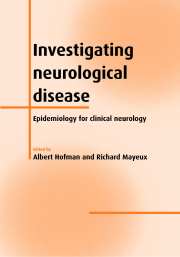Book contents
- Frontmatter
- Contents
- List of contributors
- Preface
- Part I Quantitative methods in clinical neurology
- Part II Neurological diseases
- 10 Cerebrovascular ischemic disease
- 11 Vascular dementia
- 12 Alzheimer's disease
- 13 Parkinson's disease
- 14 Multiple sclerosis
- 15 Myasthenia gravis
- 16 Guillain–Barré syndrome
- 17 Encephalitis and meningitis
- 18 HIV infection
- 19 Prion diseases
- 20 Neoplastic disease
- 21 Cerebral palsy
- 22 Migraine
- Index
12 - Alzheimer's disease
from Part II - Neurological diseases
Published online by Cambridge University Press: 29 September 2009
- Frontmatter
- Contents
- List of contributors
- Preface
- Part I Quantitative methods in clinical neurology
- Part II Neurological diseases
- 10 Cerebrovascular ischemic disease
- 11 Vascular dementia
- 12 Alzheimer's disease
- 13 Parkinson's disease
- 14 Multiple sclerosis
- 15 Myasthenia gravis
- 16 Guillain–Barré syndrome
- 17 Encephalitis and meningitis
- 18 HIV infection
- 19 Prion diseases
- 20 Neoplastic disease
- 21 Cerebral palsy
- 22 Migraine
- Index
Summary
Introduction
Alzheimer's disease (AD), alone or in combination with other disorders, is probably the most common form of dementia. It is characterized by an insidious onset with slowly progressive impairments in intellectual functions and changes in personality and emotions. The neuropathology shows extensive neuronal loss and deposition of extracellular senile plaques (SP) and intracellular neurofibrillary tangles (NFT) in the hippocampus and the frontal and temporal cortex, while the motor cortex is spared. In this chapter, we will describe the frequency of this disorder, the current hypotheses regarding its etiology, the diagnostic challenges, its prognosis, and current and future possibilities for treatment.
Frequency
The prevalence rates of AD differ as may be seen in Table 12.1 (3–15), mostly as a function of methodological differences between studies. All published studies report, however, that the prevalence of dementia and AD increases steeply with increasing age. In most studies, the prevalence is higher in men than in women among younger old people, and higher among women than among men in the very old. Regarding geographical distribution, the prevalence of dementia is similar in most parts of the world, but there are differences concerning the type of dementia. The prevalence of AD is generally higher in Western European countries and lower in Asia and Eastern Europe, while the opposite pattern is found for multi-infarct dementia. One explanation for the variation may be different rates of cerebrovascular disorders in different countries. Recently, the Honolulu-Asia Aging study reported that the prevalence of AD in Japanese–American men was similar to that in Americans of European ancestry while the prevalence of vascular dementia approached that observed in Japanese studies.
- Type
- Chapter
- Information
- Investigating Neurological DiseaseEpidemiology for Clinical Neurology, pp. 154 - 173Publisher: Cambridge University PressPrint publication year: 2001



